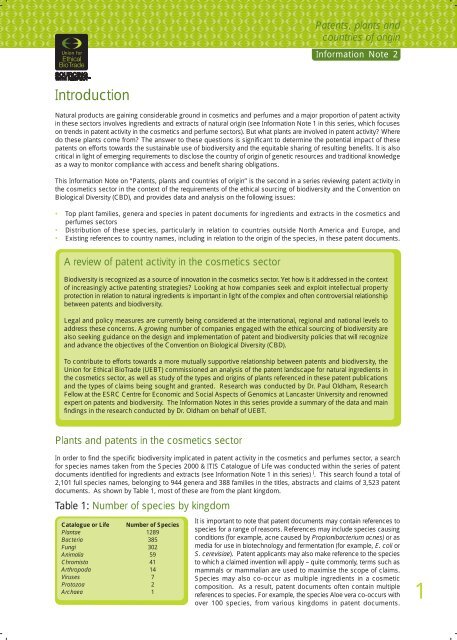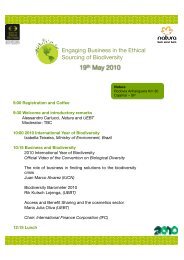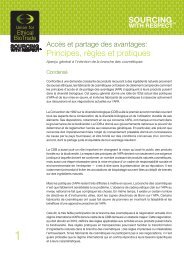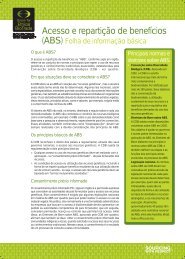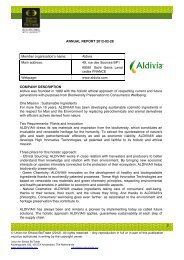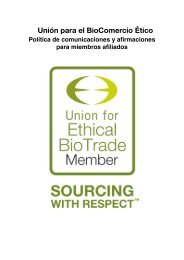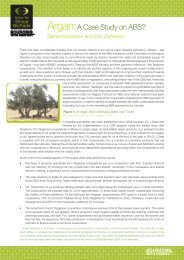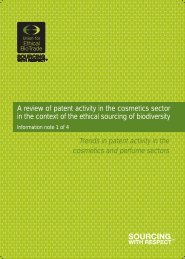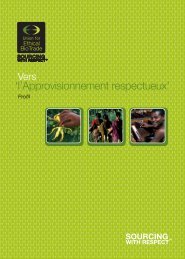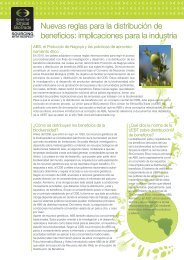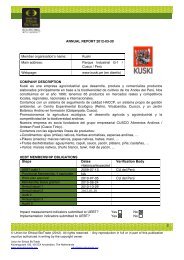A review of patent activity in the cosmetics - the Union for Ethical ...
A review of patent activity in the cosmetics - the Union for Ethical ...
A review of patent activity in the cosmetics - the Union for Ethical ...
Create successful ePaper yourself
Turn your PDF publications into a flip-book with our unique Google optimized e-Paper software.
Introduction<br />
Natural products are ga<strong>in</strong><strong>in</strong>g considerable ground <strong>in</strong> <strong>cosmetics</strong> and perfumes and a major proportion <strong>of</strong> <strong>patent</strong> <strong>activity</strong><br />
<strong>in</strong> <strong>the</strong>se sectors <strong>in</strong>volves <strong>in</strong>gredients and extracts <strong>of</strong> natural orig<strong>in</strong> (see In<strong>for</strong>mation Note 1 <strong>in</strong> this series, which focuses<br />
on trends <strong>in</strong> <strong>patent</strong> <strong>activity</strong> <strong>in</strong> <strong>the</strong> <strong>cosmetics</strong> and perfume sectors). But what plants are <strong>in</strong>volved <strong>in</strong> <strong>patent</strong> <strong>activity</strong>? Where<br />
do <strong>the</strong>se plants come from? The answer to <strong>the</strong>se questions is significant to determ<strong>in</strong>e <strong>the</strong> potential impact <strong>of</strong> <strong>the</strong>se<br />
<strong>patent</strong>s on ef<strong>for</strong>ts towards <strong>the</strong> susta<strong>in</strong>able use <strong>of</strong> biodiversity and <strong>the</strong> equitable shar<strong>in</strong>g <strong>of</strong> result<strong>in</strong>g benefits. It is also<br />
critical <strong>in</strong> light <strong>of</strong> emerg<strong>in</strong>g requirements to disclose <strong>the</strong> country <strong>of</strong> orig<strong>in</strong> <strong>of</strong> genetic resources and traditional knowledge<br />
as a way to monitor compliance with access and benefit shar<strong>in</strong>g obligations.<br />
This In<strong>for</strong>mation Note on “Patents, plants and countries <strong>of</strong> orig<strong>in</strong>” is <strong>the</strong> second <strong>in</strong> a series <strong>review</strong><strong>in</strong>g <strong>patent</strong> <strong>activity</strong> <strong>in</strong><br />
<strong>the</strong> <strong>cosmetics</strong> sector <strong>in</strong> <strong>the</strong> context <strong>of</strong> <strong>the</strong> requirements <strong>of</strong> <strong>the</strong> ethical sourc<strong>in</strong>g <strong>of</strong> biodiversity and <strong>the</strong> Convention on<br />
Biological Diversity (CBD), and provides data and analysis on <strong>the</strong> follow<strong>in</strong>g issues:<br />
• Top plant families, genera and species <strong>in</strong> <strong>patent</strong> documents <strong>for</strong> <strong>in</strong>gredients and extracts <strong>in</strong> <strong>the</strong> <strong>cosmetics</strong> and<br />
perfumes sectors<br />
• Distribution <strong>of</strong> <strong>the</strong>se species, particularly <strong>in</strong> relation to countries outside North America and Europe, and<br />
• Exist<strong>in</strong>g references to country names, <strong>in</strong>clud<strong>in</strong>g <strong>in</strong> relation to <strong>the</strong> orig<strong>in</strong> <strong>of</strong> <strong>the</strong> species, <strong>in</strong> <strong>the</strong>se <strong>patent</strong> documents.<br />
A <strong>review</strong> <strong>of</strong> <strong>patent</strong> <strong>activity</strong> <strong>in</strong> <strong>the</strong> <strong>cosmetics</strong> sector<br />
Biodiversity is recognized as a source <strong>of</strong> <strong>in</strong>novation <strong>in</strong> <strong>the</strong> <strong>cosmetics</strong> sector. Yet how is it addressed <strong>in</strong> <strong>the</strong> context<br />
<strong>of</strong> <strong>in</strong>creas<strong>in</strong>gly active <strong>patent</strong><strong>in</strong>g strategies? Look<strong>in</strong>g at how companies seek and exploit <strong>in</strong>tellectual property<br />
protection <strong>in</strong> relation to natural <strong>in</strong>gredients is important <strong>in</strong> light <strong>of</strong> <strong>the</strong> complex and <strong>of</strong>ten controversial relationship<br />
between <strong>patent</strong>s and biodiversity.<br />
Legal and policy measures are currently be<strong>in</strong>g considered at <strong>the</strong> <strong>in</strong>ternational, regional and national levels to<br />
address <strong>the</strong>se concerns. A grow<strong>in</strong>g number <strong>of</strong> companies engaged with <strong>the</strong> ethical sourc<strong>in</strong>g <strong>of</strong> biodiversity are<br />
also seek<strong>in</strong>g guidance on <strong>the</strong> design and implementation <strong>of</strong> <strong>patent</strong> and biodiversity policies that will recognize<br />
and advance <strong>the</strong> objectives <strong>of</strong> <strong>the</strong> Convention on Biological Diversity (CBD).<br />
To contribute to ef<strong>for</strong>ts towards a more mutually supportive relationship between <strong>patent</strong>s and biodiversity, <strong>the</strong><br />
<strong>Union</strong> <strong>for</strong> <strong>Ethical</strong> BioTrade (UEBT) commissioned an analysis <strong>of</strong> <strong>the</strong> <strong>patent</strong> landscape <strong>for</strong> natural <strong>in</strong>gredients <strong>in</strong><br />
<strong>the</strong> <strong>cosmetics</strong> sector, as well as study <strong>of</strong> <strong>the</strong> types and orig<strong>in</strong>s <strong>of</strong> plants referenced <strong>in</strong> <strong>the</strong>se <strong>patent</strong> publications<br />
and <strong>the</strong> types <strong>of</strong> claims be<strong>in</strong>g sought and granted. Research was conducted by Dr. Paul Oldham, Research<br />
Fellow at <strong>the</strong> ESRC Centre <strong>for</strong> Economic and Social Aspects <strong>of</strong> Genomics at Lancaster University and renowned<br />
expert on <strong>patent</strong>s and biodiversity. The In<strong>for</strong>mation Notes <strong>in</strong> this series provide a summary <strong>of</strong> <strong>the</strong> data and ma<strong>in</strong><br />
f<strong>in</strong>d<strong>in</strong>gs <strong>in</strong> <strong>the</strong> research conducted by Dr. Oldham on behalf <strong>of</strong> UEBT.<br />
Plants and <strong>patent</strong>s <strong>in</strong> <strong>the</strong> <strong>cosmetics</strong> sector<br />
In order to f<strong>in</strong>d <strong>the</strong> specific biodiversity implicated <strong>in</strong> <strong>patent</strong> <strong>activity</strong> <strong>in</strong> <strong>the</strong> <strong>cosmetics</strong> and perfumes sector, a search<br />
<strong>for</strong> species names taken from <strong>the</strong> Species 2000 & ITIS Catalogue <strong>of</strong> Life was conducted with<strong>in</strong> <strong>the</strong> series <strong>of</strong> <strong>patent</strong><br />
documents identified <strong>for</strong> <strong>in</strong>gredients and extracts (see In<strong>for</strong>mation Note 1 <strong>in</strong> this series) i . This search found a total <strong>of</strong><br />
2,101 full species names, belong<strong>in</strong>g to 944 genera and 388 families <strong>in</strong> <strong>the</strong> titles, abstracts and claims <strong>of</strong> 3,523 <strong>patent</strong><br />
documents. As shown by Table 1, most <strong>of</strong> <strong>the</strong>se are from <strong>the</strong> plant k<strong>in</strong>gdom.<br />
Table 1: Number <strong>of</strong> species by k<strong>in</strong>gdom<br />
Catalogue or Life Number <strong>of</strong> Species<br />
Plantae 1289<br />
Bacteria 385<br />
Fungi 302<br />
Animalia 59<br />
Chromista 41<br />
Arthropoda 14<br />
Viruses 7<br />
Protozoa 2<br />
Archaea 1<br />
Patents, plants and<br />
countries <strong>of</strong> orig<strong>in</strong><br />
In<strong>for</strong>mation Note 2<br />
It is important to note that <strong>patent</strong> documents may conta<strong>in</strong> references to<br />
species <strong>for</strong> a range <strong>of</strong> reasons. References may <strong>in</strong>clude species caus<strong>in</strong>g<br />
conditions (<strong>for</strong> example, acne caused by Propionibacterium acnes) or as<br />
media <strong>for</strong> use <strong>in</strong> biotechnology and fermentation (<strong>for</strong> example, E. coli or<br />
S. cerevisiae). Patent applicants may also make reference to <strong>the</strong> species<br />
to which a claimed <strong>in</strong>vention will apply – quite commonly, terms such as<br />
mammals or mammalian are used to maximise <strong>the</strong> scope <strong>of</strong> claims.<br />
Species may also co-occur as multiple <strong>in</strong>gredients <strong>in</strong> a cosmetic<br />
composition. As a result, <strong>patent</strong> documents <strong>of</strong>ten conta<strong>in</strong> multiple<br />
references to species. For example, <strong>the</strong> species Aloe vera co-occurs with<br />
over 100 species, from various k<strong>in</strong>gdoms <strong>in</strong> <strong>patent</strong> documents.<br />
1


